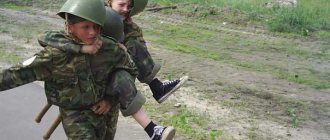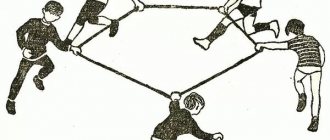Techniques for fighting for the ball
The fight for possession of the ball is one of the main tasks of a player in defense.
A complete defensive player is guided by the principle “the best defense is an attack.”
Unfortunately, we still have many players and entire teams who limit themselves to only guarding the basket and do not take any active measures to gain possession of the ball, patiently waiting for the opponent to make a mistake. This type of defensive play deserves strong condemnation.
One of the reasons for the passive defensive play of some players and teams is that most coaches pay little attention to the techniques of fighting for the ball and do not care at all about improving them. As a result, many players do not master these techniques and, of course, do not use them in the game.
Among the leading players and teams there are many real masters - “ball hunters”. An example is the player of the USSR national team K. Petkyavichus (Leningrad), who uses all the techniques of fighting for the ball in the game.
In order for a player to perfectly learn these techniques, it is necessary to systematically improve them in the educational and training process.
The main techniques in the fight for possession of the ball are: interception, knocking out, snatching and fighting for the ball after bouncing off the backboard.
Interception of the ball . Intercepting the ball is the best means of counterattack. Intercepting the ball, as a rule, takes the opponent by surprise, and thereby creates extremely favorable conditions for going on the attack.
Interception of the ball is most often possible if the attacker passes the ball inaccurately, does not meet the pass during cross passes, especially repeated ones, as well as in all other favorable cases of the game.
If the interception fails, the player must immediately stop and quickly return. To intercept the ball, the player must take an advantageous position, prepare for a quick dash and correctly determine the distance and pace of the upcoming pass.
The player’s actions must be unexpected, fast, ahead of the attacker’s actions (Fig. 60). The surprise of a jerk depends on the ability to disguise your actions. To do this, the player must demonstrate with all his appearance passivity and indifference to the upcoming pass of the ball.
The constant threat of interception affects the decisiveness of the enemy's actions.
Rice. 60. Ball interception
Knocking out the ball . The ball is knocked out of the opponent's hands either while dribbling or throwing into the basket. You can knock the ball out of your hands not only from a hesitant opponent, but also from a player who used dribbling and held the ball in his hands, or from a player who lowered his hands with the ball before throwing into the basket, and in a number of other cases.
In order to knock the ball out, the defender allows the opponent to get closer or suddenly approaches him and with a quick movement of his hand, reminiscent of the movement of a cat's paw, knocks the ball out of the opponent's hands.
Considering that the hands holding the ball form a kind of bowl, knocking the ball from top to bottom is less effective than from bottom to top, therefore it is advisable to knock the ball out with an upward movement of the hand. Since the distance between the palms holding the ball is extremely small, the ball is kicked out with the edge of the palm.
While dribbling the ball, it is advisable to kick out at the moment when the ball makes its way after bouncing from the floor to the hand. To select the ball while dribbling, another technique is used. The defender, having caught the pace of dribbling the ball, puts his hand on the ball bouncing off the floor a little earlier than the opponent and thereby takes the ball out of the opponent’s hands, continuing to dribble it himself (Fig. 61). Knocking the ball at the moment of throwing into the basket requires particularly subtle calculation and high skill. Often, a skillfully kicked ball saves the team from a sure hit. In terms of technique, this resembles the action of a volleyball player when blocking, with the hand resting on top of the ball (Fig. 62). This technique is perhaps better called covering the ball. Covering the ball when throwing into the basket is also used if the defender overtakes the attacking player at the moment when he has already begun the movement of throwing into the basket. In this case, the defender has the only means of combating the initiated throw - this is to cover the ball. In order not to make a serious mistake, the defender is obliged, without reducing the speed of his movement, to determine the direction of his movement and the position of the ball in the hands of the opponent. The defender should not move towards the player, but slightly overtake him and cover the ball at the moment when it leaves the opponent’s hands. A defender who incorrectly determines the direction of his movement and the position of the ball will make a serious personal error: he will collide with the opponent or hit his hands.
Rice. 61. Tackling the ball while dribbling
Rice. 62. Covering the ball when throwing into the basket
The defender, who has an advantage in height, fighting for the ball under the shield, uses the following technique: he retreats to the shield, and then, two or three steps from the shield, lets the attacking player past him, gives him the opportunity to start shooting into the basket, and then removes or covers the ball the moment it leaves the opponent's hands.
Snatching the ball. Snatching the ball requires subtle calculation, quick, energetic actions. The ball should be grabbed as deeply as possible, and then sharply pulled towards you. The jerk should be short and energetic. To increase the force of the jerk, it is advisable to pull out with a rotation of the body.
If the ball cannot be recovered immediately, the referee will award a held ball. The awarded ball is a partial victory for the defender.
Snatching the ball is used in cases where the opponent holds the ball in his hands, when the opponent lands after catching the ball in a jump, especially when playing from the backboard, and also in cases where the opponent is dribbling the ball.
Recently, players have successfully used snatching the ball from players finishing the dribble. The defender carefully watches the player dribbling the ball, and, having determined the end of the dribble, quickly grabs the ball a little earlier or simultaneously with the opponent.
The player of the USSR national team L. Alekseeva successfully uses a ball snatch after the player has caught the ball, standing with his back to the direction of movement and having lost orientation in the position of the defender, makes a turn and tries to start dribbling or other action. An unexpected face-to-face encounter with a defender gives the defender an advantage to capture the ball (Figure 63).
Rice. 63. Snatching the ball
The fight for the ball that bounces off the backboard is typical for both defensive and offensive actions.
In order to avoid repetition, we described this technique in the chapter “Attack”.
Games and relay races (basketball) material on physical education on the topic
Game basketball exercises.
When teaching team sports, it is impossible to build a lesson without game exercises that lead to the study of the main game. They help to practice this or that skill and consolidate the material covered in a playful way. What game exercises are best to use in basketball lessons?
Run after the ball.
Players line up in groups of 3 or 4 at the free throw line. In front of each column at a distance of 3 m there is a captain with a ball. At the teacher’s signal, he passes the ball to the first player in the column, who, having caught the ball, passes it back, runs after it and stands behind the captain. He catches the ball and passes it to the second player, who repeats the actions of the first, etc. The game ends when the entire team lines up behind the captain (see Fig. 1).
Rice. 1
Ball to the center.
Option 1. Players line up in three circles. In the middle of each circle is the captain with the ball. At the teacher’s signal, he passes the ball to the players in a circle in a clockwise direction, and they pass it back to him. The game ends when the captain receives the ball from the last player. The team that finishes the game first wins.
Option 2. After all the players receive the ball and pass it to the captain, one of them changes roles with him. The team in which all players complete the task before their opponents wins.
Passed it on - sit down.
At the teacher's signal, the captain passes the ball to the first player. He, having caught the ball, returns it to the captain and assumes a crouching position. The captain catches the ball, passes it to the second player, etc. The team that completes the task before its opponents wins (see Fig. 2).
Rice. 2
Tulking while dribbling the ball.
Option 1. Players take the balls, disperse around the room and begin dribbling the ball. One of them is appointed as the driver, who tries to make one of the players look bad. The upset player then becomes the driver.
The game can be played in pairs.
Option 2. The exercise becomes more complicated: the driver tries to knock the ball away from him without hitting the other player.
Relay race with dribbling the ball.
The players line up in a column of 3. At the signal, the first numbers begin dribbling the ball, bypassing the flags, and, returning back, pass the ball to the next players. The team that finishes the relay first wins (see Fig. 3).
Rice. 3
Relay race with dribbling and throwing the ball.
At the signal, the first numbers dribble the ball to the opposite hoops, take two steps and throw the ball into the hoop, then pass the ball to the next players and stand at the end of the column. The relay ends when one of the teams finishes within 2-3 minutes. will throw as many balls into the hoop as possible. After this, the number of hits is counted, and the teams change rings: column No. 3 goes to ring No. 7, column No. 2 goes to ring No. 8, and column No. 1 goes to ring No. 2. The teams change places 2 times. The team with the most hits wins (see Fig. 4).
Rice. 4
Bombers.
At the signal, players shoot into the ring, recording the number of hits. After 1.5–2 minutes. upon a signal, they change rings counterclockwise. The team with the most hits wins (see Fig. 5).
Rice. 5
Fight for the ball.
Two teams are participating. The players of the team that has taken possession of the ball must make 10 passes to each other, and their opponents try to interfere with them and, having taken possession of the ball, try, in turn, to make 10 passes to each other. For every 10 passes successfully completed, the team receives 1 point. The game is played according to the rules of basketball.
Options: a) game with dribbling the ball, b) game without dribbling the ball.
Relay race with dribbling and passing the ball.
Players line up in a column of 3 at a distance of 2–3 m from each other. The first player has the ball. At the signal, he turns and passes the ball to the second participant, the second to the third, etc. The latter, having received the ball, begins dribbling, snakes around each player on his team and stands at the head of the column. The team thus moves back one player. The relay ends when the first player leads the column again. The team that finishes the exercise first wins.
Dot.
2 or more players participate. If a player (team member or number one) hits the hoop from a certain point, then all other players must hit the hoop from the same place. If the next player in line misses, he receives a penalty point, and the next thrower can change the point of the throw, etc. Having received 5 penalty points, the student is eliminated from the game.
Ball to the captain.
Two teams play according to the rules of basketball, but instead of shooting around the ring, the participants pass the ball to their captains, who are located in the free throw zones.
Options:
a) game with dribbling the ball; b) playing without dribbling the ball.
Sniper.
The game involves several players with balls. The goal is to hit the hoop as often as possible from behind the 6-meter line within 1-3 minutes.
Sun.
Players must hit the hoop from each of the 7 spots. When hit from point No. 1, you need to move to point No. 2, etc. (see Fig. 6).
Rice. 6
Look!
At the signal, the first player passes the ball to the second, who passes the ball to the third, etc. until the last one, who returns the ball to the first player again. After this, the game starts over. As you master the game, its pace and number of balls increase (see Fig. 7).
Rice. 7
Basketball in grades 4–11. Teaching ball handling techniques.
- The ball is in the palm of the right hand extended forward. Double-sided catching - palm, back of the hand. The same, with the other hand.
- Throwing the ball from hand to hand (palms up).
- Rotation of the ball around the neck, torso, legs.
- "Eight". I. p. wide stance with legs apart. Passing the ball from hand to hand between the legs, draw a figure eight.
- "Slap on the thighs." Throwing a ball above you and catching it after slapping your hips.
- "Ricochet". I. p. wide stance with legs apart, ball in hands in front. With both hands we hit the ball on the floor so as to catch it from behind (to catch the ball from behind, the blow to the floor must be made in the area of the heels). Then, holding it behind your back, we also hit the ball on the floor near the heels and catch it from the front.
- "Arch". I. p. ball in hands behind back. We throw the ball up over our head and catch it from the front with both hands in front of our chest.
- "Cradle". I. p. wide stance, legs apart, holding the ball between the legs: right hand in front, left hand behind the legs. Change the position of your hands, trying not to drop the ball.
- "Swing your leg." I.p. basic stance, ball in right hand. Swing with the right foot, passing the ball from the right hand to the left hand under the foot; swing with the left leg, the ball from the left hand to the right under the foot. Dribbling the ball around your foot.
- I. p. wide stance with legs apart, figure eight lead.
- Dribbling the ball around your feet.
In basketball, dribbling the ball is an important technical technique, without which it is impossible to imagine a full-fledged, tactically competent game. Already in the first lessons of teaching basketball, I formulate in students the idea that dribbling the ball is the movement of a player with continuously successive pushes of the ball on the floor with one or alternately with both hands. From lesson to lesson, schoolchildren are convinced that the main thing in the technique of dribbling the ball is the lack of visual control, asynchronous work of the arms and legs, the equivalence of dribbling the ball with the right and left hands, high speed of movement, rational position of the hand on the ball, active movement of the arm in the elbow joint. The existing types of dribbling the ball - high and low - enable the player to move the ball around the court at different speeds and in any direction. Using this technique, you can escape from a tightly guarded opponent, go under the hoop, shoot while moving, transfer the ball from the backcourt to the frontcourt, take the ball away from a crowd of players, change attack positions, and stretch the defense.
I begin learning how to dribble the ball in the 4th grade; in subsequent grades, the technique is improved and consolidated by increasing speed and changing the direction of movement, alternating dribbling the ball with the right and left hand. In 9th grade, according to the school curriculum, students must master the skill of dribbling the ball when approaching an opponent.
I teach how to dribble the ball using the following method. As you know, first the player’s stance is studied, then the movements - running, jumping, stopping, stepping, turning. I begin to teach actual dribbling with preparatory exercises – one-time hits of the ball on the floor. Then I invite students to combine these techniques with taking a stance and moving with an extended step forward and backward, right and left. After this, we use repeated hits on the floor with the right and left hands, first standing still, then running in place and with small movements in different directions and with different heights of the ball’s rebound. Improving dribbling skills, students perform movements dribbling the ball in a straight line, as well as in an arc and circle at various distances, varying the places where the ball hits the floor depending on the nature and pace of movement. Gradually, students switch to dribbling the ball after catching it in motion. The study of dribbling when approaching an opponent is completed. In parallel with teaching new material, the previously learned motor skills are being improved and consolidated. I have been using this gradual expansion of my playing skills for five years now, using the methodological techniques, exercises, and also outdoor games I have developed to improve dribbling. Exercises and games diversify basketball lessons, make them more emotional, and increase the density of classes. I pay the most attention to dribbling the ball without visual control. At the initial stage of learning to lead, I recommend that students bring their free hand with the edge to their nose. In this case, with the head in a straight position, the student does not see the ball, and peripheral vision is also excluded. Both standing still and in motion, this type of guidance is used with closed eyes.
Sample game tasks and outdoor games for dribbling the ball in motion.
"Cross dribbling." The exercise is performed while running at an average pace, duration – 2-3 minutes. During the exercise, the teacher gives a signal for low or high leading, with or without visual control. Dribbling is carried out around the basketball court or diagonally, in arcs. The cross has the following stages: leading by running, side steps with the right side, then the left side, back forward, jumping, in a full squat, leading with acceleration diagonally, with a 360° turn, with jerks and stops at a signal. All game tasks are performed with the right hand, then with the left hand, alternately with the right and left with different rebound heights.
"Brownian (disorderly) motion." Up to 40 low racks are placed in random locations throughout the gym. The class is divided into 2-3 teams, each with no more than 10 players. Teams are given 1 minute, during which the players, dribbling the ball, must go around as many posts as possible, making a circle around each one. The number of posts bypassed by all team members is summed up, thus identifying the winning team. Personal competitions can also be held. You must dribble the ball for the entire minute; you cannot take the ball in both hands. Driving is carried out with one hand or alternately with the right and left hands. The height of the ball's bounce is adjusted by a signal from the teacher. If in grades 4–6, dribbling is performed with any hand, regardless of the position of the racks, then in high schools, dribbling is carried out with the farthest hand from the racks, as if imitating dribbling the ball when approaching an opponent.
The games used in lessons to improve dribbling have also proven themselves well.
"Tags with dribbling." Two players, moving in the same direction around a post or a third player standing in the center of the circle and dribbling the ball with the farthest hand from the opponent, try to hit each other on the shoulder with their free hand and not lose the ball. Players are allowed to move their opponent's free hand away with their hand to avoid getting greased. The one who managed to touch the opponent’s shoulder without losing the right to dribble gets 1 point. If control of the ball is lost, 1 point is awarded to the opponent and the player who made the mistake changes places with a partner standing in the circle. Option: without interrupting the dribble, everyone tries to take the ball from the opponent.
"Watchman." The game is played by two people, each with a ball. Player 1 (guard), dribbling the ball, protects the flag placed on the floor behind him. The “guard” is allowed to take steps with one foot, the other (supporting) stands 25-30 cm from the flag. Player 2’s task is, without stopping dribbling, to touch the flag with his free hand, which, according to the terms of the game, brings him 1 point. With a predetermined score, players change roles. Option: the guard, moving and dribbling the ball around the hoop lying on the floor, prevents player 2 from getting the ball into the hoop. He, too, using dribbling, tries to deceive the guard and send the ball into the hoop. The guard is allowed to hit the ball with his free hand.
"Keen Eye" The class is divided into three teams, which line up in columns one at a time. There is a hoop in front of each team at the starting line. 10 - 15 m from it there are 5 multi-colored flags: red, black, white, green, blue. 5 m from the line of flags, another line is drawn parallel to it - for the movement of the teacher, who has 5 flags of the same color in his hands. At the signal, the first numbers of the team begin dribbling the ball around the hoop, constantly watching the teacher, who quickly moves in different directions along his line. As soon as the teacher raises one of his flags, the first team numbers, without stopping dribbling, must run to their flags, take one of them of the desired color and, dribbling the ball, quickly return to their team. The participant who did not make a mistake, took the required flag, and returned to the starting line the fastest brings his team 3 points, the second - 2 and the third - 1 point. For mistakes, no points are awarded. Then the second numbers come into play, etc. The team with the most points wins.
"Leading after the pass." The class is divided into pairs. Partners stand 5 meters away from each other. The first player passes the ball to the second. The second one immediately transfers the ball to dribble, dribbling the ball, runs to the first one, circles him and returns to his place with the dribble, after which he makes a pass to the first one. The exercise is repeated several times.
"Pick up the ball." In pairs, the position of the partners is the same as in the previous game. At the signal, the first number, dribbling the ball, runs up to the second and, stopping, quickly moves the ball from a high dribble to a low dribble - until the ball stops completely. Then, leaving the ball at his partner’s feet, he runs back to his place. The second player, with frequent strokes of the hand on the ball, transfers the ball to dribble and then repeats the actions of the first.
“Repeat the leader.” The game is played in pairs, each pair has one ball. The player with the ball stands behind the player without the ball. At the teacher’s command, the player without the ball begins to move freely around the hall, making sharp accelerations, stops, and changing the direction of movement. The partner with the ball must, while dribbling the ball, repeat all the movements of the leader and stay behind him as closely as possible.
"Around your partner." In pairs, the distance between partners is 2 meters. At the teacher’s signal, the student without the ball begins to slowly move forward with side steps, and his partner dribbles the ball around him. After one lap around the gym, the players change roles.
"Snake". The players line up in two columns, the distance between students is 2 meters. The players in the first column have balls. At the teacher’s signal, the second column of players without balls begins to slowly move at a pace around the hall. Pupils of the first column dribble the ball in a “snake” run between the walking students of the second column. After two circles, the columns change places.
Option: distance between students – 4 m; a column of students with balls moves while dribbling the ball both along the second column and towards it. I evaluate the skill of dribbling the ball not when performing this technique in isolation, but when students pass through an obstacle course close to the game environment. I also use the obstacle course to comprehensively improve this game action. On the obstacle course, it is possible to simulate all sorts of situations during dribbling that may occur directly in the game. Thus, the obstacle course becomes like an intermediate link between improving individual techniques with dribbling the ball and performing them in training and control matches. The obstacle course allows you to: objectively evaluate your driving technique; improve gaming skills in activities as close to the game as possible; train students' motor memory; clearly identify errors in the technique of dribbling the ball and find productive ways to eliminate them. As a rule, I use the obstacle course starting from the 6th grade. In grades 4-5 I include only individual elements of it in classes. The improvement and evaluation of dribbling techniques takes place in the form of combined relay races, but not on speed, but on the technique of performing techniques. From class to class the relay races become more difficult. If in grades 7-8 I give a grade for dribbling the ball based on the number of mistakes made, then in grades 9-10, in addition to the mistakes made, I also take into account the time it took to complete the obstacle course. The approximate content and location of individual elements of the obstacle course for dribbling a ball for students in grades 9-10 in a 9 x 18 m sports hall are shown in the figure.
Sample stages of an obstacle course.
- Catching the ball with both hands after a long pass. The clock starts as soon as the player's hands touch the ball.
- Outlining 6 racks, located 1 meter apart from each other, with a hand that is comfortable for the player. Outline 5 racks, located 2-3 meters from each other, with the hand farthest from the rack.
- While standing still, dribble the ball with a comfortable hand in a figure eight between two low (50 cm) posts. The distance between the posts is 0.5 m.
- Driving along a corridor between two gymnastic benches located at a distance of 45 cm.
- After dribbling, stop with a jump and pass the ball from the chest with both hands to a partner standing in the center circle. Then catch the ball with one hand and turn it over to dribble in a circle with the farthest hand from the center of the circle. This part of the exercise is performed with both the right and left hands. Guidance is carried out without visual control.
- While dribbling the ball, hitting 5 hoops lying on the floor at a distance of 1.5–2 meters from each other (3 hoops are located in a straight line, the last 2 form an isosceles triangle with the third).
- Dribbling with a comfortable hand the ball from the right and left sides from three gymnastic sticks, placed halfway in one line (in grades 4 - 5, with the right and left hands alternately)
- Dribble the ball with your right hand and around your supporting left leg, then with your left hand around your supporting right leg (turn to the left, then to the right).
- After dribbling the ball, take two steps followed by a throw into the basket (the stopwatch is stopped at the moment the ball leaves the hands).
Getting ready to play basketball
The purpose of game tasks and relay races: mastering the elements of basketball, training the ability to distribute attention, developing accuracy and speed of movements. The choice of tasks is determined by the conditions, number and health status of participants. Games can be played in pairs, teams, and everyone can participate, including adults.
- Players stand in columns at a distance of 3 m from the wall. The guides, having thrown one hand from the shoulder into the wall, run to the end of their column. The second number catches the rebounded ball and repeats the action of the first, etc. The column that finishes the exercise first and makes fewer mistakes wins.
- The player stands facing the corner of the hall at a distance of 3–4 m from both walls and throws the ball in any way at one or the other wall for 20 seconds. The one who manages to throw the ball the most times within the specified time wins.
- Two players stand at a distance of 4-6 steps from each other, each with a ball in their hands. At a signal, they throw the balls up (about 3 m) and, changing places, catch them without bouncing off the floor.
- The ball is in your hands behind your back. At the signal, players throw it over their heads and catch it in front of them. The winner is the one who completes the exercise 10 times faster without dropping the ball.
- Two people stand opposite each other at a distance of 5–6 m and simultaneously pass the ball to each other (for example, with both hands from the chest). After passing, they must clap twice in front of their chest and catch the ball flying from their partner. The pair that passes the ball the most times in 2 minutes wins.
- Relay race: dribbling the ball (right, left), circling obstacles on the left and right, throwing at the backboard, catching the ball and dribbling in the opposite direction. The team that finishes the exercise faster wins.
Outdoor games based on basketball for 3rd grade
Schoolchildren perform complex tasks. Before the lesson, the basic elements are repeated (throws, dribbling along different trajectories, interceptions).
"Calling numbers"
The groups stand in rows. After paying, students remember their numbers. Commanders name any numbers. The called participants catch the ball from the main one, dribble to the indicated line, and make throws. They return at the signal.
"Knock the ball out"
With one palm they guide the projectile, with the other they knock it out from others. The child walks off the playground empty-handed. At the end there are 3 winners who “knocked out” the rest, keeping their ball.
"With a jump rope"
Two people stand separately, swinging a jump rope. The first player comes forward, dribbling the ball. His goal: to get under the rope without touching it. Touching is a penalty point. Other children do this.
What else to read: Outdoor musical game “Sunshine and Rain” for the younger group
"Get control of the ball"
Two columns stand on a line and are being calculated. The striker serves, calling the chosen number. Everyone who did not take possession of the ball and shoot into the basket becomes defenders. They interfere with serves. Points are given as follows: possession of the ball – 1, throw into the basket – 2, successful defense – 2.
"Mass basketball"
There are 5 members from each group on the field. The rest stand behind the line, catching passes and sending the ball back. The game is played between 10 basketball players on the field.
"Fast Break"
3 participants play. At the signal, the team with the ball breaks through to the opposite basket. There they play until the second signal.
The influence of outdoor games on child development
Outdoor games in basketball contribute to:
- physical development (speed, accuracy, endurance);
- moral improvement (honesty, self-control, respect for boundaries and rules);
- intellectual growth (savvy, strategic thinking, attentiveness);
- socialization of the child (establishing contacts, finding compromises, understanding the partner).
Players make decisions that lead to the overall team outcome. All participants take turns leading. This equality gives children confidence.
Fun starts with basketball elements
"Fun Starts" for grades 3-4. Developed by a teacher of the highest category Ivanov Nikolay Andreevich
Goals:
1. Promotion of a healthy lifestyle.
2. Fostering a sense of collectivism, camaraderie, mutual assistance, and creative thinking.
3. Fostering a “healthy spirit of competition.”
From class: team of 6 people
Equipment: skittles, large balls, buckets, jump ropes, hats, jackets, mittens, briefcases, scarves, umbrellas, hoops, basketballs.
Progress of the lesson:
Construction. Greetings from the teams.
Team places are determined by the shortest total time of all relays. If two or more teams have the same amount of time, the team that showed the best time in the head-to-head relay gets an advantage.
Rules for relay races.
- The finish line of each relay race is the starting line.
- Boys start first, followed by girls (unless otherwise specified in the relay conditions).
- For passing the relay by throwing a ball (gymnastic stick or other equipment), a penalty time of -0.5 seconds is awarded. The accrual of penalty time for other violations is stipulated in the relay conditions.
- RELAY RACE – “HOOP JUMPING”.
Equipment: hoop (diameter 70 cm).
Starting position: The entire team is lined up in a column in the following order: boy, girl, boy, girl, etc. There is a hoop on the floor at a distance of 6 m from the starting line.
Description of the relay:
On the command “March”, the participant runs to the hoop, takes it and makes two jumps in place, rotating the hoop over his head, puts the hoop in place, and runs back.
Conditions: A penalty point is awarded for a missed jump.
The baton is passed to the next participant by touching the hand.
- RELAY RACE – “SYNCHRONICITY”.
Equipment: 1 gymnastic stick.
Starting position: Team members are lined up in pairs (in two lines) according to the following pattern: boy-girl, girl-girl, boy-boy, boy-girl.
Description of the relay: 2 participants hold on to a gymnastic stick on both sides with the hand farthest from the edge of the stick. After passing the baton, without taking their hands off the stick, the participants begin to move forward, synchronously stepping over the stick. After stepping over, the gymnastic stick sweeps over the participants’ heads and returns to its original position.
Conditions: The task is completed until the turning point, bypassing which the participants return back.
At least 5 synchronized steps must be performed in each direction.
For each step that is not completed, a penalty time of 3 seconds is awarded. The baton is passed to the next pair by passing the gymnastic stick.
- RELAY RACE – “CROSSING”.
Equipment: 2 “bumps” (bump board, size 40x30 cm).
Starting position: The whole team participates. The participants are lined up in a column - first boys, then girls.
Description of the relay: “bumps” that they move along the floor, moving towards the turning mark. The task is to quickly walk along the “bumps” to the turning mark, without touching the floor with your foot.
Conditions: For each foot touching the floor, those walking on “bumps” are awarded a penalty point.
The baton is passed by passing “bumps”.
- COMPLEX RELAY RACE (5 people participating).
Stage 1 – “Driving the basketball.”
Equipment: basketball.
Participant: 1 boy.
Description of the stage: The participant moves forward while performing an introduction exercise with a basketball. Having bypassed the turning mark, the participant also returns back.
Conditions: If the participant drops the ball, he continues to perform the task from the place where the ball fell.
The relay is passed to the participant in the next stage by passing the ball from hand to hand (you cannot throw it).
Stage 2 – “run for the ball”
Inventory: 1 basketball.
Participant: 1 young man.
Description of the stage: Having received the ball from the participant of stage 1, the young man throws the basketball forward and runs after it, catches it and runs back.
Conditions: the ball must roll to the wall.
The relay is passed to the participant in the next stage by passing the ball from hand to hand (you cannot throw it).
Stage 3 – DRIVING THE BASKETBALL
Inventory: 1 basketball.
Participant: 1 girl.
Description of the stage: The participant dribbles the basketball to the turning mark with her right hand (at least 6 times), rounding the turning mark, returns back dribbling the ball with her left hand (at least 6 times).
The relay is passed to the participant in the next stage by passing the ball from hand to hand (you cannot throw it).
Stage 4 – “KANGAROO”
Inventory: 1 basketball.
Participant: 1 girl.
Description of the stage: The participant holds the basketball between her legs and performs jumps on two legs until the turning mark, rounding which she also returns back.
Conditions: If a participant drops the ball, she returns it to its original position from the place where the ball fell and continues to perform the task until she crosses the starting line with a two-legged jump.
Stage 5 – DRIVING AND PASSING THE BASKETBALL IN PAIRS
Inventory: 1 basketball.
Participants: 2 boys.
Description of the stage:
The boys stand on the starting line at a distance of 2 m from each other. The start of the stage after the participant of the previous stage has crossed the start line with a jump on two legs.
Moving face forward as they move, the participants dribble and pass the basketball to each other as it bounces off the floor. Moving towards the turning mark, they need to complete at least 6 dribbles and passes of the basketball to each other. Having run around the turning mark, the participants return, moving at a side step facing each other at a distance of 2 meters and pass the ball from the chest (at least 6 times).
Conditions: If the participants lose the ball, they continue to perform the task from the place where the ball fell.
The baton is passed to the pair of the next stage with a clap on the hand.
- COUNTER RELAY.
Equipment: relay baton.
Starting position: The whole team participates. The participants are lined up in two opposing columns - boys in one column, girls in the other. At the starter's signal, the first boy begins to move. Having reached the girls' line, she passes the baton to the first girl, the girl runs towards the boys, etc. the participant who comes running stands at the end of the column. The relay continues until the opposing columns change places.
Relay finish: the last participant crosses the starting line.






